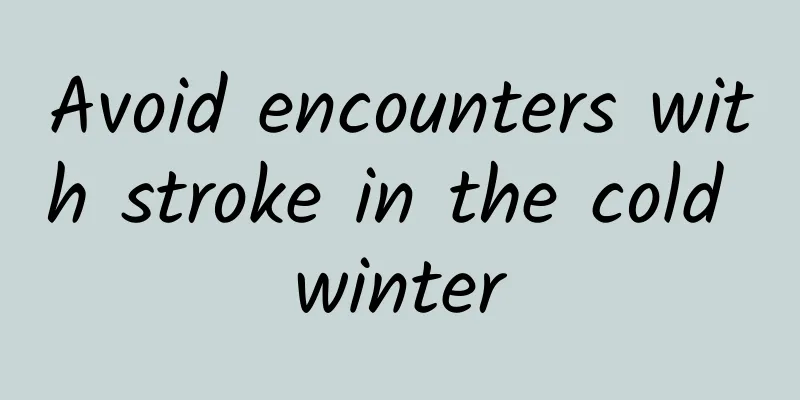Avoid encounters with stroke in the cold winter

|
At present, stroke has become the third leading cause of death among Chinese residents, second only to malignant tumors and heart disease. According to estimates, there are about 2 million new stroke patients each year in the country, and 1.5 million to 2 million people die from stroke each year. Since the beginning of winter this year, most parts of northern my country have been affected by cold waves, and the temperature has dropped drastically, increasing the meteorological risk of inducing stroke. People with cardiovascular and cerebrovascular diseases should be extra careful to prevent them before they happen. Recently, the reporter asked Professor Sun Shentian, the first national famous Chinese medicine doctor and doctoral supervisor of the Second Affiliated Hospital of Heilongjiang University of Chinese Medicine, to provide a popular science interpretation on the hot topic of cerebral stroke. Why does stroke emergency come about? Stroke, scientifically known as cerebral infarction, is an acute cerebrovascular event. Sun Shentian explained that cerebral infarction is a group of diseases caused by sudden rupture or blockage of blood vessels in the brain, which prevents blood from flowing into the brain, thus causing brain tissue damage. It is divided into ischemic stroke and hemorrhagic stroke. Whether it is ischemic stroke or hemorrhagic stroke, it will cause varying degrees of brain tissue damage, produce a variety of neuropsychiatric symptoms, and even endanger life in severe cases. Even after recovery, many people will still have sequelae that affect their normal work, study and life. As the "number one" enemy that endangers public health, people must be highly vigilant and pay attention to it, and curb the invasion of stroke from the source. Sun Shentian concluded that from the perspective of traditional Chinese medicine, stroke is caused by four major problems: deficiency of vital energy, improper diet, excessive emotions, and internal injuries caused by fatigue, which in turn lead to disorder of qi and blood, and promote the combination of wind, fire, phlegm, and blood stasis, causing blockage of brain veins or blood overflow outside the brain veins, and eventually develop into cerebral stroke. Its main clinical manifestations are sudden fainting, unconsciousness, crooked mouth and eyes, poor speech, hemiplegia, limb weakness or inflexibility, unstable walking, severe headache, nausea and vomiting, impaired consciousness, etc. In mild cases, hemiplegia and loss of control of legs and feet occur, and in severe cases, patients are wheelchair-bound for life. Which groups are more susceptible to stroke? Which groups are more likely to suffer from stroke? Sun Shentian introduced that, first of all, from the perspective of gender, the incidence and mortality of stroke among Chinese residents are higher in males than in females in both rural and urban areas; the average age of male and female stroke patients is 65.5 and 67.6 years old respectively. Sun Shentian explained that the reason for this difference may be closely related to the fact that men prefer to smoke, drink alcohol, eat too much fat and sweet food and other unhealthy lifestyles. In the age group of 80 years and above, the incidence of stroke in women exceeds that of men. At the same time, stroke patients are becoming younger. According to a survey in Heilongjiang Province, the incidence of stroke in people under 40 years old is 5 to 6 times that of southern provinces and 2 to 3 times that of other northern provinces. This is because most young people now have the same living environment and habits, such as fast pace of life, high mental pressure, fierce competition at work, often staying up late, using computers or mobile phones for a long time, often eating takeout or high-calorie fast food, having a habit of smoking and drinking, being generally overweight and lacking exercise. Sun Shentian also introduced that according to the geographical distribution survey of cerebrovascular diseases in my country, except for the Tibet Autonomous Region, the incidence of stroke in most provinces is high in the north and low in the south, high in the east and low in the west. Experts and scholars found in their research on climate change and neurological diseases that the incidence of stroke greatly increases under the impact of low temperatures; at the same time, the drastic change in ambient temperature is closely related to the mortality rate of stroke; the mortality rate of stroke is lowest in areas with suitable temperatures, while the mortality rate in cold areas is significantly increased. In addition, the onset of stroke is also characterized by seasonality and time period, that is, winter is much higher than summer; the peak incidence is from early morning to noon. Clinical treatment is time-sensitive. Clinically, within 6 hours of a sudden stroke (preferably within 4.5 hours) is called the "golden time" for rescue. Within this rescue time window, patients must undergo surgery or thrombolytic therapy in a timely manner to avoid disability or even death. From Sun Shentian's experience, acupuncture intervention in the early stages of stroke is effective, especially for the rehabilitation of limb movement, language, swallowing and other functions. This is because acupuncture stimulation immediately after ischemia can significantly increase local cerebral blood flow and promote effective blood supply to ischemic tissues to counteract brain damage caused by insufficient blood supply; at the same time, acupuncture during the reperfusion period after ischemia can help improve blood and oxygen supply to brain tissue, significantly reduce the area of cerebral infarction, and protect nerve function from further damage. It should be emphasized that for stroke, prevention is far more important than treatment. Sun Shentian introduced that the risk factors of stroke are divided into two categories: interventionable and non-interventionable. The former include age, gender, race, genetics, etc., which are innate and cannot be changed; while the latter include hypertension, heart disease, diabetes, atherosclerosis, dyslipidemia, smoking, alcoholism, obesity, emotional stress, etc. Through human intervention, such problems are fully expected to be solved. Take hypertension as an example. As the cruelest invisible killer of cerebral hemorrhage and cerebral infarction, the higher the blood pressure, the greater the probability of stroke. Only by putting a "bridle" on the soaring blood pressure can we prevent stroke. The results of a clinical randomized controlled trial of systolic hypertension in elderly hypertensive patients in China showed that after 4 years of follow-up, the mortality rate of the antihypertensive treatment group was 58% lower than that of the placebo control group. Five cornerstones need to be built firmly. Here, Sun Shentian advises readers to attach importance to building the "five cornerstones" of health, namely, a reasonable diet, moderate exercise, quitting smoking and limiting alcohol, psychological balance, and treating chronic diseases. Specifically, first of all, blood pressure should be monitored regularly, salt intake should be limited, and the fat content in the diet should be reduced. The daily salt intake should be less than 6 grams. Excessive intake of sodium, fat and cholesterol can easily bury the risk of atherosclerosis. Secondly, patients with hypertension should insist on taking antihypertensive drugs to regulate blood pressure below 140/90 mmHg. Third, regular and moderate physical exercise is essential. Sun Shentian believes that aerobic exercise can enhance heart function, increase cerebral blood flow, improve microcirculation, and maintain an ideal weight, without giving stroke a chance. Fourth, quit smoking and limit alcohol, and put an end to the bad habits of smoking and drinking. Sun Shentian explained that smoking is a definite independent risk factor for ischemic stroke and subarachnoid hemorrhage. Studies have shown that the amount of alcohol consumed is positively correlated with the risk of ischemic stroke. Drinking less can reduce the probability of stroke, while excessive drinking can cause a stroke to come uninvited. Finally, Sun Shentian also warned that people should pay attention to keeping a happy mood, actively adapt to the objective environment, and take positive measures to adjust negative emotions; at the same time, avoid fatigue, focus on strengthening physical fitness, balancing mentality, and nourishing positive energy to improve disease resistance and stress resistance. For those who have already developed the disease and have sequelae, do not rush for success, but should focus on preventing the recurrence of stroke, and "not chasing after the past" to avoid the re-invasion of stroke pathogenic factors. Copyright Notice: This article is transferred from: China Traditional Chinese Medicine News |
Recommend
Feeling of falling during early pregnancy
In the early stages of pregnancy, there is a feel...
How old is a woman?
Women's sexual desire peaks when they reach t...
Hormone changes after abortion
Artificial abortion is a relatively common method...
Coughing in the spring? Experts: Beware of "asthma without wheezing"
As spring approaches, the number of patients in t...
Does rice wine have a high sugar content? What is the best cup to drink rice wine with?
Rice wine, also known as fermented glutinous rice...
What kind of body is prone to premature delivery
Because each mother has a different physical cons...
Is it normal to have breast milk after abortion?
There are many factors that prompt women to choos...
What happens if you eat spicy food when your aunt comes?
During menstruation, women's body functions a...
Is biopsy necessary for colposcopy?
Colposcopy and biopsy are very common gynecologic...
What should I do if there is residue after two months of medical abortion?
If you have to have an abortion, it is recommende...
How to download the Love Apartment 5 emoji pack on WeChat? Tutorial on how to add the Love Apartment 5 emoji pack to WeChat
Love Apartment 5 has come to an end, and many peo...
Does breast pain occur during pregnancy?
After pregnancy, a woman's breasts will under...
Brown discharge during mid-menstrual period
If many women have symptoms of scanty menstrual f...
Bathing like this in the summer can easily lead to illness. How much do you know about these 8 mistakes you must avoid making when bathing?
Editor's Note In summer, bathing has become a...
What should I pay attention to when recovering from my second childbirth?
For many families, children are the most importan...









